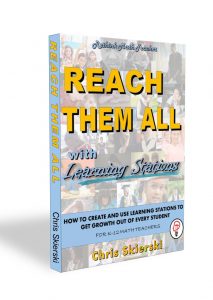
Often, math skills build on previously learned material. If a student lacks the required prerequisite knowledge to complete the task at hand, the teacher is left with the decision of remediating the child(ren) or pushing them ahead knowing that they can’t do the grade level work.
2) Cheating Issues
People often take shortcuts, we’re all guilty of it. But obviously, when you cheat in school, you bypass the learning element, ensuring that you won’t master the material.
But today, cheating is easier than ever. A friend can take a screenshot of their homework and send it to another. Or the student can even download an app that will walk them through the step by step way to solve the problem.
3) Math Blocks
Some students have the notion that they are “not good at math.” This thought is a pervasive one in our society, being propagated by the masses, and reinforced through a variety of outlets into the minds of our students daily.
Helping students get over this mental math block is a challenge.
4) Absences
When a student misses a key portion of the instruction, it is difficult for them to catch up, as they will have to cover this in makeup work – which often goes undone, or without the aid of a good instructor. The more absences a student racks up, the further behind they become.
5) Differentiated Learners
With the above-mentioned issues, you have a room full of students all with missing pieces of prerequisite knowledge. Making the effort to get all of them on grade level a difficult task. How can you reach each student, where they need help the most?
If you’ve been following Rethink Math Teacher for a while, you know that I am now going to recommend that using Learning Stations to differentiate instruction will help combat these issues.
1) I build stations for the specific skills necessary to complete the grade level work that we are working on in the class. I put students in that station for remediation work until they master that skill. I then progress them through the stations until they can do the grade level work. This way, prerequisite knowledge no longer hinders my students. I simply plug the holes in their math repertoire until they’re on grade level.
For more information, read “Remediation that Works – Plugging the Holes.”
2) With the learning stations that we teach at Rethink Math Teacher, at the end of the station the student is assessed. So if they were cheating, they will not pass the assessment, and then they repeat the station to continue practicing the skill until they master it. This way, even if they’ve cheated on the classwork or homework, they won’t pass the assessment, and thus, they don’t move on to another skill.
3) Many students struggle with the feeling of not being good at math because they have not mastered so many of the prerequisite skills, so they are expected to do work that they are ill-equipped to complete. With learning stations, when you plug those holes and celebrate the students’ success, the student gains confidence. As they see themselves mastering more and more skills, they realize that they can be good at math, and this gives them the courage to press on.
4) Absences are tough to combat. However, when a student is absent and you are using Learning Stations as we teach, when they return, they pick right up on the skill they were working on when they were absent. This way, they don’t get left behind.
5) No matter the students learning disability, disadvantage, or difference, when they are met at their level, and given enough practice with immediate feedback they will grow.
If you’d like to learn more about Learning Stations, I recommend the following two articles:
Finally, we do have an eBook coming out soon that will help you better understand learning stations as well as walk you through all the steps you need to create and implement them. Subscribe to the webpage to get updates, as it is scheduled to be released near the end of the Summer of 2018.
If you found this post helpful, remember to share it on social media

















